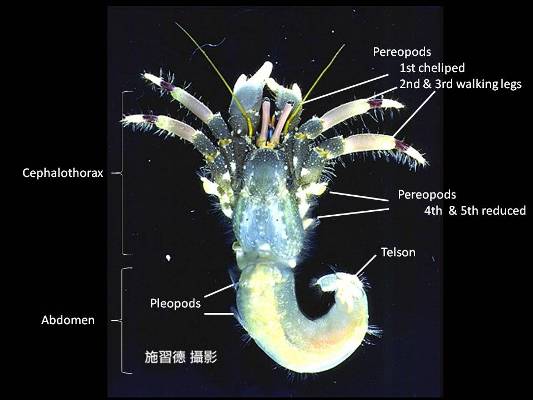Segmentation & Appendages
Segmentation
Malacostracans have 20 segments; five in the head, eight in the thorax, and six in the abdomen (Ruppert, Fox & Barnes 2004). The head segments and first three thoracic segments are fused to form a cephalothorax (Ruppert, Fox & Barnes 2004). The calcification of cephalothorax occurs minimally in hermit crabs, restricted only to the anterior gastric region (Forest et al 2000). The asymmetrical abdomen of hermit crabs are covered with thin, soft and non-segmented cuticle, and modified to fit into right-handed snail shells by twisting instead of being flexed beneath the cephalothorax (Ruppert, Fox & Barnes 2004). Thus hermit crabs are soft and defenseless without outside shells.
Appendages
Hermit crabs have five pairs of pereopods. The first pair, chelipeds may function as operculum, second and third pairs are used as walking legs, and forth and fifth pairs are reduced. Pleopods are reduced or lost on the right side; on the left side they are retained in females to carry eggs, whereas in males they may be reduced or lacking (Forest et al. 2000; Ruppert, Fox & Barnes 2004). The telson consisting of 2-4 lobes is only weakly calcified.

|
|
The bodies of hermit crabs show the intermediate characteristics of crabs and shrimps.
(Figure adapted from Shih 2012)
|
|